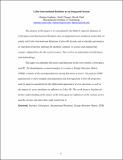| dc.contributor.author | Vaishnav, Chintan H. | |
| dc.contributor.author | Choucri, Nazli | |
| dc.contributor.author | Clark, David D. | |
| dc.date.accessioned | 2016-07-20T16:40:42Z | |
| dc.date.available | 2016-07-20T16:40:42Z | |
| dc.date.issued | 2013-11 | |
| dc.identifier.issn | 2194-5403 | |
| dc.identifier.issn | 2194-5411 | |
| dc.identifier.uri | http://hdl.handle.net/1721.1/103775 | |
| dc.description.abstract | The purpose of this paper is to conceptualize the hitherto separate domains of Cyberspace and International Relations into an integrated socio-technical system that we jointly call the cyber International Relations (Cyber-IR) system and to identify and analyze its emergent properties utilizing the methods common to science and engineering systems adapted here for the social sciences. Our work is an exploration in both theory and methodology. This paper (a) identifies the actors and functions in the core systems, Cyberspace, and IR, (b) disambiguates system boundary, (c) creates a design structure matrix (DSM), a matrix of the interdependencies among functions of actors, (d) analyzes DSM qualitatively to show multiple interdependent and heterogeneous Cyber-IR properties, and (e) analyzes quantitatively the differential importance of core functions as well as the impact of actor attributes on influence in Cyber-IR. This work forms a baseline for further understanding of the nature of the heterogeneous influences of the various actors and the various outcomes that could result from it. | en_US |
| dc.description.sponsorship | United States. Office of Naval Research (ONR award number N00014-09-1-0597) | en_US |
| dc.publisher | Springer US | en_US |
| dc.relation.isversionof | http://dx.doi.org/10.1007/s10669-013-9480-3 | en_US |
| dc.rights | Creative Commons Attribution-Noncommercial-Share Alike | en_US |
| dc.rights.uri | http://creativecommons.org/licenses/by-nc-sa/4.0/ | en_US |
| dc.source | Springer US | en_US |
| dc.title | Cyber international relations as an integrated system | en_US |
| dc.type | Article | en_US |
| dc.identifier.citation | Vaishnav, Chintan, Nazli Choucri, and David Clark. “Cyber International Relations as an Integrated System.” Environment Systems and Decisions 33, no. 4 (November 17, 2013): 561–576. | en_US |
| dc.contributor.department | Massachusetts Institute of Technology. Computer Science and Artificial Intelligence Laboratory | en_US |
| dc.contributor.department | Massachusetts Institute of Technology. Engineering Systems Division | en_US |
| dc.contributor.mitauthor | Vaishnav, Chintan H. | en_US |
| dc.contributor.mitauthor | Choucri, Nazli | en_US |
| dc.contributor.mitauthor | Clark, David D. | en_US |
| dc.relation.journal | Environment Systems and Decisions | en_US |
| dc.eprint.version | Author's final manuscript | en_US |
| dc.type.uri | http://purl.org/eprint/type/JournalArticle | en_US |
| eprint.status | http://purl.org/eprint/status/PeerReviewed | en_US |
| dc.date.updated | 2016-05-23T12:17:17Z | |
| dc.language.rfc3066 | en | |
| dc.rights.holder | Springer Science+Business Media New York | |
| dspace.orderedauthors | Vaishnav, Chintan; Choucri, Nazli; Clark, David | en_US |
| dspace.embargo.terms | N | en |
| dc.identifier.orcid | https://orcid.org/0000-0002-2676-889X | |
| dc.identifier.orcid | https://orcid.org/0000-0002-1153-8880 | |
| dc.identifier.orcid | https://orcid.org/0000-0002-6756-7795 | |
| mit.license | OPEN_ACCESS_POLICY | en_US |

